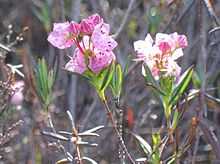Kalmia polifolia
| Kalmia polifolia | |
|---|---|
 | |
| Scientific classification | |
| Kingdom: | Plantae |
| (unranked): | Angiosperms |
| (unranked): | Eudicots |
| (unranked): | Asterids |
| Order: | Ericales |
| Family: | Ericaceae |
| Genus: | Kalmia |
| Species: | K. polifolia |
| Binomial name | |
| Kalmia polifolia Wangenh. | |
| Synonyms | |
|
Chamaedaphne glauca | |
Kalmia polifolia, commonly called bog-laurel or swamp laurel,[1] is an evergreen shrub of cold acidic bogs, in the family Ericaceae. It is native to north-eastern North America, from Newfoundland to Hudson Bay southwards.
Its leaves are arranged oppositely on the branch. They are waxy with an entire, revolute margin. The base of the petiole is pressed against the stem. Below each leaf base there are ridges, where it appears as though a part of the leaf is curled around the circumference of the stem. This is especially noticeable lower on the plant. This plant is related to Labrador Tea Ledum Groenlandicum, which native Americans used to make a drink from its leaves.
Bog-laurel contains grayanotoxin, which when ingested lowers blood pressure, and may cause respiratory problems, dizziness, vomiting, or diarrhea.[2]
References
- ↑ "USDA GRIN Taxonomy".
- ↑ Paul Alaback, Joe Antos, Trevor Goward, Ken Lertzman, Andy MacKinnon, Jim Pojar, Rosamund Pojar, Andrew Reed, Nancy Turner, Dale Vitt (2004). Jim Pojar and Andy MacKinnon, ed. Plants of the Pacific Northwest Coast (Revised ed.). Vancouver: Lone Pine Publishing. p. 53. ISBN 978-1-55105-530-5.